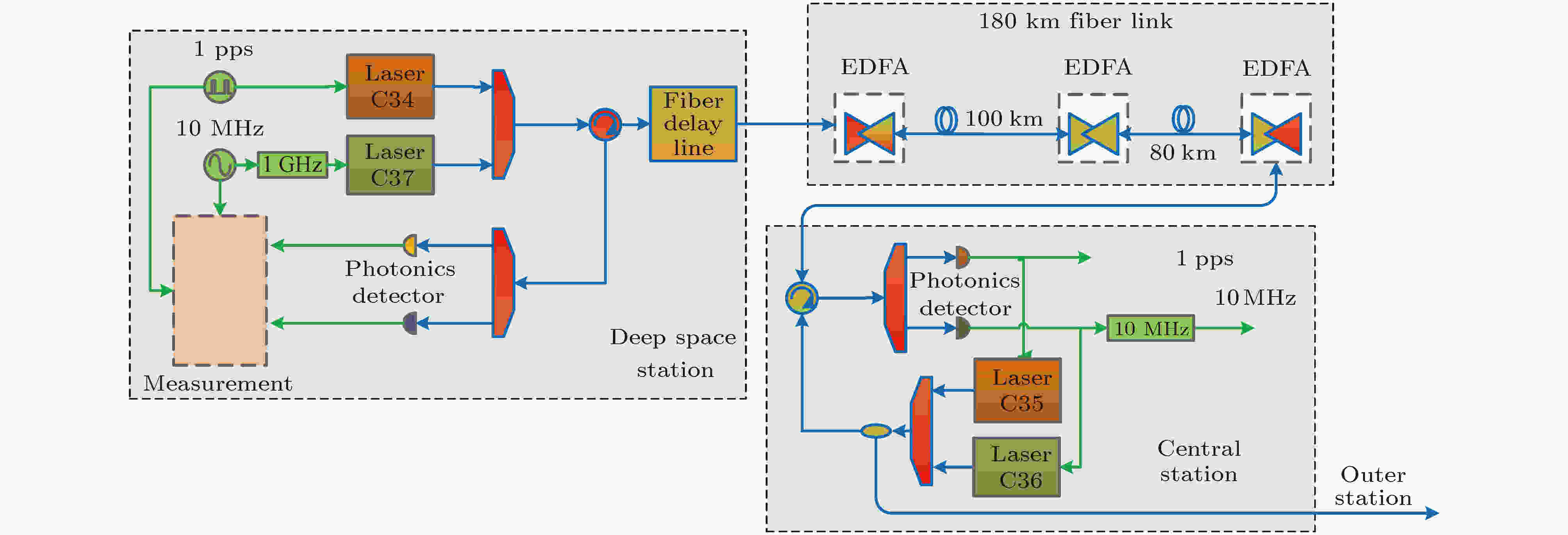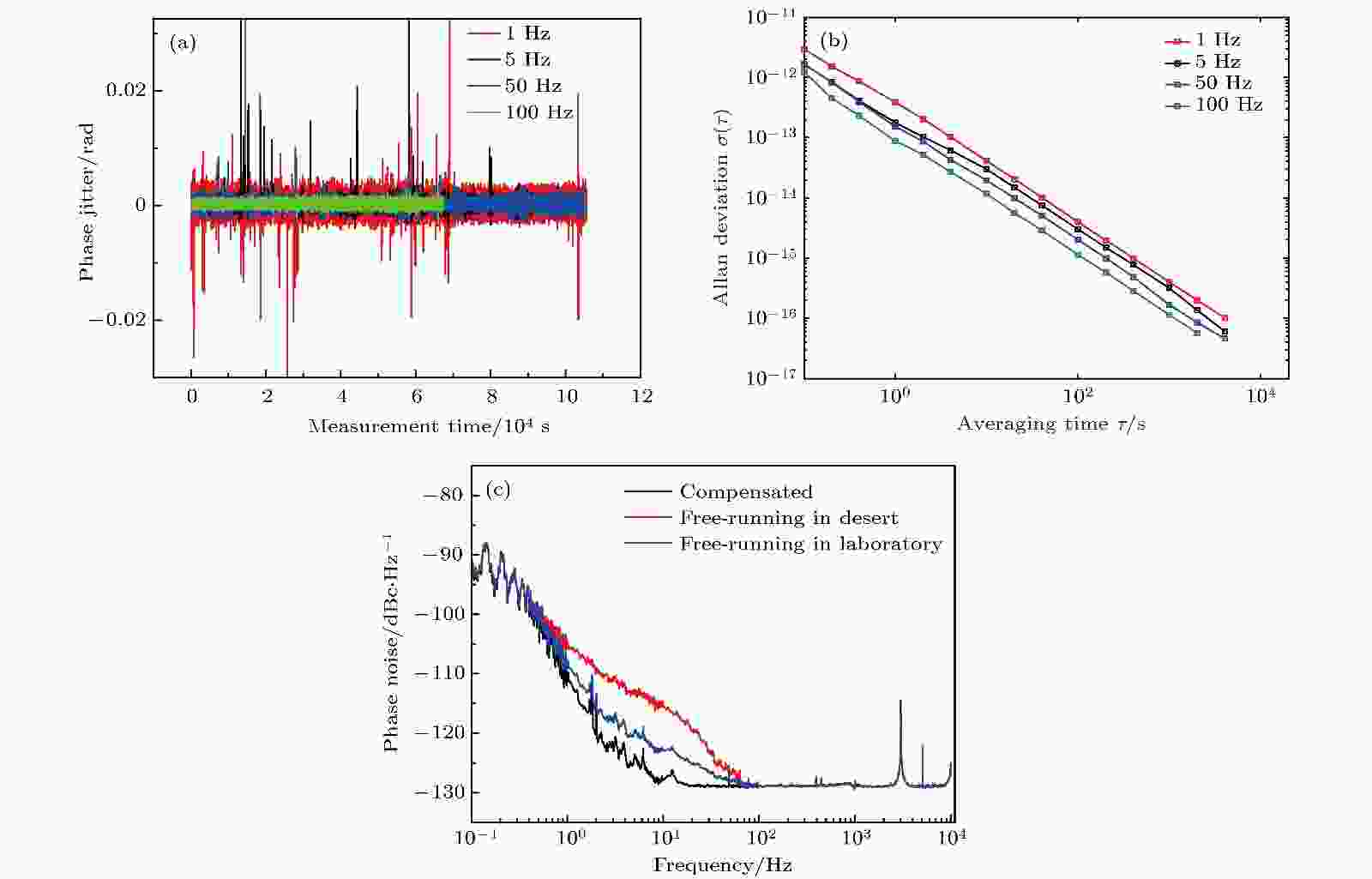全文HTML
--> --> -->近年来, 由于光纤具有低损耗、抗电磁干扰、高稳定性等特征, 基于光纤的时频传递技术发展迅速, 相关研究结果已经证实了该方法能实现比传统卫星传递方式更高的时频传递精度, 得到国内外同行的广泛重视. 国际上, 法国和波兰的研究工作者先后报道了在商用链路上的射频信号传递[13,14]; 德国的研究工作者实现了光频信号在1840 km光纤上的稳相传输[15]. 在国内, 本研究组通过波分复用的方式实现了氢钟频率信号和秒脉冲信号的同时传递, 通过两级级联方式实现了430 km长距离实验验证[16,17]; 清华大学相关研究组实现了时间频率共同传递并实现了50 ps的时间传递精度[18]. 然而, 长距离实际光纤链路的环境要比实验室链路复杂得多, 特别是沙漠光纤链路存在温度变化大、室外风力、地表振动等多种复杂噪声来源. 实际链路中由于线路老化、租用的运营商线路接续点多等导致光纤端面反射带来的杂散噪声大, 长距离传输链路补偿带宽受限, 链路大范围时延突变的补偿能力要求等都是需要重点考虑的因素. 尽管国内外在基于实际光纤链路的时频传递技术有较多研究, 但是在诸如沙漠条件等极端恶劣环境下的长距离光纤时频传递系统研究鲜有报道. 沙漠条件下实际光纤链路架空光缆长、温度变化剧烈带来的大范围时延突变以及线路老化等原因带来光功率损耗大等是主要技术难点. 因此, 研究在沙漠等极端条件下影响光纤时频传输系统性能的限制因素, 探索其中的关键技术难点, 可为未来满足战场条件或恶劣环境条件下的高精度长距离时频同步需求提供可能的解决方案.
本文报道了在新疆某基地沙漠条件的复杂实地链路环境下, 通过光纤时频稳相传输, 将氢钟产生的10 MHz和1 pps信号传递到距离200 km左右的两个观测站. 本文针对上述沙漠环境下光纤时频传递系统的主要技术难点, 分析了链路中噪声的成分和来源, 重点研究了在时频稳相传输过程中, 反馈补偿带宽、补偿强度、光载波强度等系统参数对传递稳定度的影响, 得到了复杂实地链路环境下的光纤时频传递补偿反馈参数优化配置方案. 该光纤稳相时频传输系统在基于短基线干涉测量的卫星测轨系统中发挥了重要作用.
 图 1 实地光纤链路铺设情况
图 1 实地光纤链路铺设情况Figure1. Schematic of urban fiber link.
高精度光纤时频传递系统如图2所示, 包含两级传递系统: 一级传递系统将深空站处的时频信号传到远端首区节点再生, 同时作为用户信号和往二级传递系统传递, 最终送往新区节点. 由于两级系统的组成结构和实现方式都是相同的, 在图2中只画出了一级系统结构, 本文也仅对一级系统做详细介绍. 将深空站节点处的氢原子钟的10 MHz正弦频率信号倍频到1 GHz后经过光发射端机调制到波长为C37的光波信号上, 采用更高的频率可以有效地提高传输的信噪比; 同时将本地端的1 pps时间信号调制到C34的光波信号上, 并通过波分复用技术经过环形器进入到光纤链路中. 到达远地端首区节点后, 通过探测器解调分别得到频率和时间信号, 一部分通过降频器降频作为时频信号输出给首区节点处的用户使用, 另一部分通过调制光波信号继续传递给下一级链路. 链路频率稳定度的测量是通过鉴相设备采集得到链路频率传输的相位差抖动数据, 并对相关数据进行统计分析可以得到噪声的阿伦方差表征. 由于在实地外场实验中, 受实际条件的限制, 本地端和远地端的时频信号处于不同的物理位置, 难以直接评估远地端与本地端时频信号的相对波动, 因此通过中心站测量本地频率和远端环回频率的相位稳定性来评估时频传递系统的性能. 而关于此系统的对称性我们在实验室条件下做过细致的验证, 验证结果表明中心站的测量结果足够表征远端频率的相位稳定性.
 图 2 高精度光纤时频传递系统
图 2 高精度光纤时频传递系统Figure2. Schematic diagram of the frequency transfer and time synchronization system.
由于实地链路同时包含架空及埋地光缆, 会受到室外风力、地表振动等多种干扰, 噪声来源非常复杂, 因此在详细研究不同系统补偿反馈参数对于链路噪声的抑制能力前, 需要对链路噪声成分做一些半定量化的系统分析, 从而为提出抑制室外复杂实地链路噪声的光纤时频传递补偿反馈参数配置方案提供数据支撑.
首先, 为了对反馈补偿系统的动态范围进行有效设计, 需要了解整体光纤链路随环境变化而产生的长时间时延漂移. 在实验中, 将时频传递系统置于开环测试环境, 通过相位分析, 测量频率信号的相对相位漂移, 根据光纤相位与温度的关系, 反演出作用在光纤链路上的温度波动, 测试结果如图3(a)所示. 由于180 km光纤中有140 km是埋地光缆, 因此180 km整体光纤温度平均变化范围较小, 为4 ℃左右, 对应时延变化范围为24 ns左右. 然而40 km架空光缆的昼夜温差大于16 ℃, 这反映了沙漠环境下温差变化大的特征, 如图3(a)内插图所示. 为此, 设计了一款中心风道散热的温控延迟线, 如图4(a)所示. 在兼顾体积与功耗的前提下, 得到了较大的时延变化范围. 在此结构设计的基础上, 一个5 km的温控延迟线可以具有7 ns以上的时延动态范围, 这样通过6组5 km温控延迟线的组合, 得到了大于42 ns的时延动态变化范围, 其时延变化测试结果如图4(b)所示, 保证了对于环境变化引起的长时间时延漂移的足量补偿.
 图 3 (a)环境温度波动测量结果; (b)频率相位快速抖动噪声
图 3 (a)环境温度波动测量结果; (b)频率相位快速抖动噪声Figure3. (a) Environmental temperature vibration; (b) fast frequency phase jitter noise.
 图 4 (a)温控延迟线构造示意图; (b) 5 km温控延迟线性能测试结果
图 4 (a)温控延迟线构造示意图; (b) 5 km温控延迟线性能测试结果Figure4. (a) Construction of fiber delay line; (b) test result of fiber delay line.
其次, 在室外光纤链路的情况下, 除了由温度变化带来的大范围缓慢时延漂移外, 还存在着由于风力、机械振动等引起的频率相位快速抖动. 将系统置于仅有温控延迟线的弱反馈补偿环境下, 以便观察链路中的快速相位抖动噪声, 实验结果如图3(b)所示. 由图3(b)可见, 在长时间的缓慢相位抖动漂移被温控延迟线成功抑制的情况下, 系统还存在着大量的相位快速抖动噪声, 根据相位与时延的换算关系, 可知此类快变噪声带来的时延变化幅度在10 ps左右. 对于此类噪声, 设计了压电陶瓷(PZT)延迟线, 通过快速拉伸改变光纤长度来实现补偿, 其响应速度达到kHz量级, 补偿范围约为17 ps.
此外, 对于时间信号而言, 由于时间信号和频率信号经过相同的光纤链路, 光纤延时线在稳定频率信号的同时, 也抑制了链路噪声对于时间信号的影响, 但由于时间与频率传递采用了不同的激光频率, 链路噪声对时间信号和频率信号的影响仍存在差异. 我们之前的研究结果表明200 km链路产生的残余信号抖动小于20 ps[19], 远小于1 pps信号自身产生的抖动, 据此可以认为本文系统同时实现了时间与频率信号的稳相传输.
基于以上分析, 下文主要详述频率信号传递的相位抖动噪声抑制及高精度时频信号传递结果. 通过详细研究不同系统补偿反馈参数对于链路噪声的抑制能力, 来重点探究得到能有效抑制室外复杂实地链路噪声的光纤时频传递补偿反馈参数配置方案.
首先, 由于链路中噪声成分的复杂性, 需要精细地调整补偿系统的反馈强度和带宽, 力求得到最好的链路噪声抑制效果. 在反馈强度方面, 通过改变温控延迟线的工作电流来进行反馈强度的改变, 相关的实验结果如图5所示. 由图5(a)蓝线可见, 当慢变延迟线工作电流较低时, 相位波动中存在很多抖动噪声无法被有效地抑制. 这是由于在较低的工作电流时, 温控延迟线的升降温速率较慢, 因此当链路中噪声带来的时延抖动速率大于延迟线的最快补偿速率时, 就会在相位波动曲线中形成一个尖峰; 而随着慢变延迟线工作电流的增加, 抖动噪声被更好地抑制, 如图5(a)黑线所示. 将得到的相位抖动数据计算得到阿仑方差, 如图5(b)所示. 由图5(b)可见, 通过调整慢变延迟线工作功率, 低于1 Hz傅里叶频率的低频噪声得到不同程度的抑制, 这和慢变延迟线的补偿带宽也是一致的. 此外, 在实验中发现进一步提高慢变延迟线的工作电流已经不能得到更好的相位抖动抑制结果, 这说明此时图5中残余的相位抖动噪声的带宽已经大于慢变延迟线的补偿范围. 而过大的慢变延迟线工作电流反而会对延迟线自身带来更大的散热压力, 因此针对我们所应用的具体链路环境, 优化设定慢变延迟线工作电流为1.6 A. 当链路所处环境温度特性发生改变时, 需要对于不同的实际环境实地优化温控电流设置值, 以取得最佳的效果. 目前也正在研究自适应的时频系统补偿方案, 基本原理是通过反馈模块的误差信号变化值感知链路中的时延变化, 并通过时延变化量的大小和快慢设置最佳的温度延迟线电流设置值, 以提升系统的实用性.
 图 5 (a)不同延时线工作电流下的相位抖动; (b)不同延时线工作电流下的阿伦方差
图 5 (a)不同延时线工作电流下的相位抖动; (b)不同延时线工作电流下的阿伦方差Figure5. (a) Phase jitter for different delay line’s working current; (b) the Allan deviation for different delay line’s working current.
其次, 对于图5(a)中残余链路相位抖动噪声, 可以由更高时延补偿带宽的快速光纤PZT延时线进行补偿. 在实验中, 通过在反馈控制程序中加入特定的固有程序延时来得到不同的补偿带宽, 并观察不同补偿带宽下相位抖动噪声抑制后的情况, 实验结果如图6所示. 由图6(a)可见, 随着反馈补偿带宽的不断加大, 链路中存在的快速相位抖动噪声不断地被抑制; 而另一方面, 链路中的补偿带宽应小于1/4t (t为单向传输时延), 否则会引入额外的噪声[20]. 更进一步地, 在远端通过降频及锁相净化技术得到10 MHz频率信号, 由于电子锁相环的有限带宽(<100 Hz), 锁相带宽外的高频噪声不会引入到恢复频标信号中. 因此结合不同补偿带宽下的实验结果与180 km的链路传输距离, 通过反馈控制程序的精确控制, 将系统补偿带宽优化调整为100 Hz. 系统参数优化配置后得到的噪声抑制效果如图6(a)绿线所示. 由图6(b)可见, Allan方差在补偿带宽内呈现了良好的




 图 6 (a)不同反馈带宽下的相位抖动噪声; (b)不同反馈带宽下的噪声阿伦方差; (c)不同情况下的链路相噪测试结果
图 6 (a)不同反馈带宽下的相位抖动噪声; (b)不同反馈带宽下的噪声阿伦方差; (c)不同情况下的链路相噪测试结果Figure6. (a) Phase jitter in different feedback bandwidth; (b) the Allan deviation in in different feedback bandwidth; (c) phase noise in different conditions.
最后, 如前文所述, 我们通过放置3台自研的低噪声掺铒光纤放大器来补偿链路光功率的传输损耗. 更进一步地, 掺铒光纤放大器的增益倍数必须合理地设置, 过小的光功率会使远端的信号解调过程带来较大的噪声, 过大的光功率也会带来额外的非线性效应和散射噪声. 在实验中, 通过光纤放大器的增益系数的改变实现对光纤链路的光功率管理并详细测试了不同链路光功率下得到的频率相位抖动噪声, 实验结果如图7所示. 在实验中, 光纤放大器均工作在自动功率控制模式, 即通过调整增益倍数, 使得在光纤放大器的输入光功率在–25 dBm至–15 dBm范围时, 输出的放大后光功率稳定在一个固定值. 由图7可见, 当链路中光功率较大时, 会激发非线性效应的散射噪声, 由此产生较大的相位抖动噪声; 而当链路中光功率较小时, 探测器解调信号过程中进入探测器光功率较低, 又会由于探测器的热噪声和散粒噪声得到较低的信噪比. 因此结合本文实验结果和分析, 通过对光纤放大器增益倍数的精确调整, 我们将通过自动功率控制技术将光纤放大器的输出稳定在5 dBm左右, 得到最低的链路相位抖动噪声. 此外由于EDFA器件本身的发热特性, 因此在实验中通过采取散热片和风扇共同散热的方式, 将它对频率长期稳定性的影响降到最低.
 图 7 (a)不同链路光功率下的的相位抖动噪声; (b)不同链路光功率下的噪声阿伦方差
图 7 (a)不同链路光功率下的的相位抖动噪声; (b)不同链路光功率下的噪声阿伦方差Figure7. (a) Phase jitter in different link optical powers; (b) the Allan deviation in in different link optical powers.
 图 8 (a)反馈补偿前后的相位噪声阿伦方差; (b)反馈补偿前后的时延抖动偏差
图 8 (a)反馈补偿前后的相位噪声阿伦方差; (b)反馈补偿前后的时延抖动偏差Figure8. (a) The Allan deviation in free running and compensated conditions; (b) time deviation (TEDV) in free running and compensated conditions.
